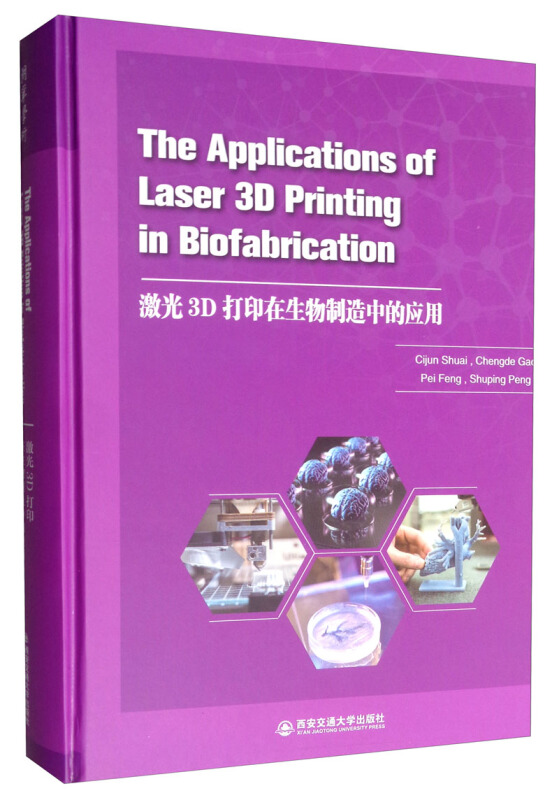
包邮激光3D打印在生物制造中的应用

温馨提示:5折以下图书主要为出版社尾货,大部分为全新(有塑封/无塑封),个别图书品相8-9成新、切口有划线标记、光盘等附件不全详细品相说明>>
- ISBN:9787569304442
- 装帧:精装
- 册数:暂无
- 重量:暂无
- 开本:其他
- 页数:368
- 出版时间:2018-03-01
- 条形码:9787569304442 ; 978-7-5693-0444-2
内容简介
It has long been one dream of mankind to repair or reconstruct the defective tissues/organs by using biomedical implants, which have similar shape, structure and function to the natural tissues/organs. As the world's most populous country, China has entered the aging society since the end of the 20th century, and is expected to supplant Japan as the world's most aging country in 2030. The aged is a highrisk and vulnerable population of serious diseases and accidental injuries because of the decline of physiological function, weak control over environment and the phenomenon of "empty nest". As a result, trssue/organ defects are growing rapidly and there has been an ever-increasing demand for biomedical implants. In order to repair the defective tissues/organs, a biomedical implant should not only mimic the material characteristics and gradient structure of the defective sites, but also have sufficient mechanical properties to support cells and withstand complex stresses inthe physiological environment. Meanwhile, the implant should possess controllable degradation rate and favorable osteoinductivity. These complex structures, harsh performance and individual differences put forward great challenges for the fabrication methods of biomedical implants. So far, biomedical implants are fabricated mainly by forging, casting and machining, which requires not only complex molds but also high cost for single-piece production. More importantly, traditional fabrication methods are difficult to obtain the gradient structure and performance of implants. Therefore, it has become a huge challenge to manufacture personalized biomedical implants for the repair and regeneration of defective tissues/organs.
目录
Nanodiamond reinforced polyvinylidene fiuoride/bioglass scaffolds for bone tissue engineering
Graphene oxide as an interface phase between polyetheretherketone and hydroxyapatite fortissue engineering scaffolds
A combined nanostructure constructed by graphene and boron nitride nanotubesreinforces ceramic scaffolds
A space network structure constructed by tetraneedlelike Zn0 whiskers supporting boron nitride nanosheets to enhance comprehensive properties of poly(L-lacti acid) scaffolds
Chapter Ⅱ Oxides reinforced biomaterials by laser 3D printing
Biosilicates scaffolds for bone regeneration: infiuence ofintroducing Sr0
A mesoporous silica composite scaffold: cell behaviors, biomineralization andmechanicalproperties
MgO whiskers reinforced poly (vinylidene fiuoride) scaffolds
Chapter Ⅲ Alloying elements in biomedical metals by laser rapid solidification
Laser rapid solidification improves corrosion behavior of Mg-Zn-Zr alloy
Microstructure evolution and biodegradation behavior oflaser rapid solidified Mg-Al-Zn alloy
Influence of alloying treatment and rapid solidification on the degradation behavior and mechanical properties of Mg
Preparation and characterization of laser-melted Mg-Sn-Zn alloys for biomedical application
Rare earth element yttrium modified Mg-Al-Zn alloy: microstructure, degradation properties andhardness
……
Chapter Ⅳ Liquid phase-assisted densification in laser 3D printing
Chapter Ⅴ Combination of different types of biomaterials by laser 3D printing
-

图解新能源汽车 原理·构造·诊断·维修
¥96.0¥128.0 -

中国传统酿造酒醋酱
¥38.1¥128.0 -

公路路基设计规范
¥54.9¥98.0 -

零担货物运输网络中绿色物流的枢纽选址与路径规划:英文版
¥57.2¥78.0 -

图解汽车线束技术
¥55.6¥78.0 -

土壤与地下水污染生态环境损害鉴定评估技术
¥35.6¥48.0 -

再话土力学
¥54.9¥98.0 -

金属切削液配方与制备手册
¥144.5¥198.0 -

中国近现代超级工程地理分布图
¥16.8¥20.0 -

集成电路制造工艺与工程应用
¥69.3¥99.0 -

(社版)XG管道分质直饮水供水技术与工程
¥55.6¥78.0 -

汽车故障综合诊断技术
¥63.7¥95.0 -

用于固态锂金属电池的钛酸镧锂基电解质研究
¥48.0¥58.0 -

汉服经典纹样与配色图鉴
¥117.6¥168.0 -

LNG船舶夜航安全评估
¥32.4¥56.0 -

高速列车空气动力学设计技术
¥102.4¥128.0 -

新型电力系统与新型能源体系
¥27.5¥98.0 -

科学论证:逻辑与科学评价方法:logic and scientific evaluation method
¥89.6¥128.0 -

河南省水资源——第三次水资源调查评价
¥144.0¥200.0 -

基于整体性治理的农村水环境共治模式研究
¥61.1¥78.0












